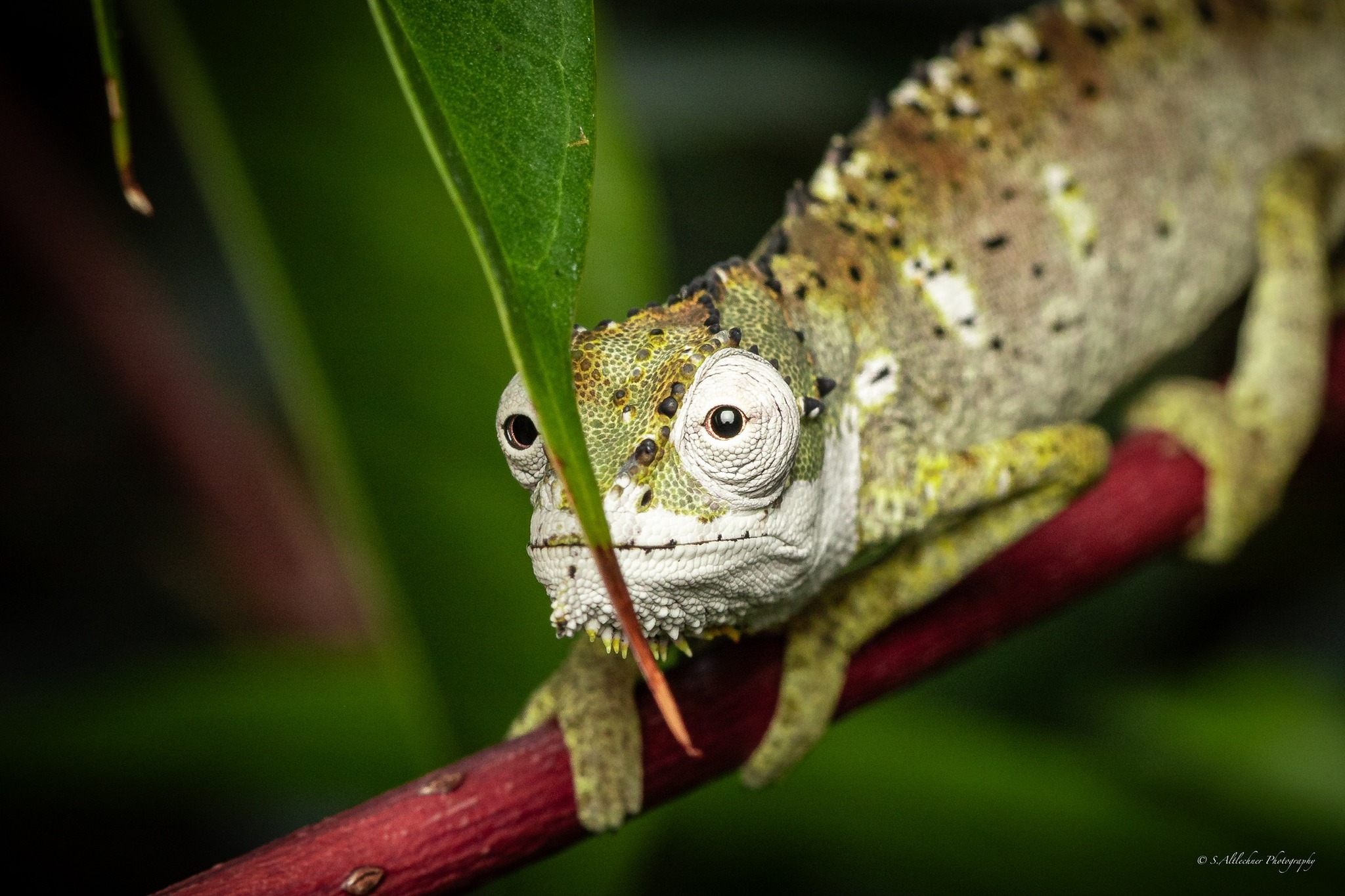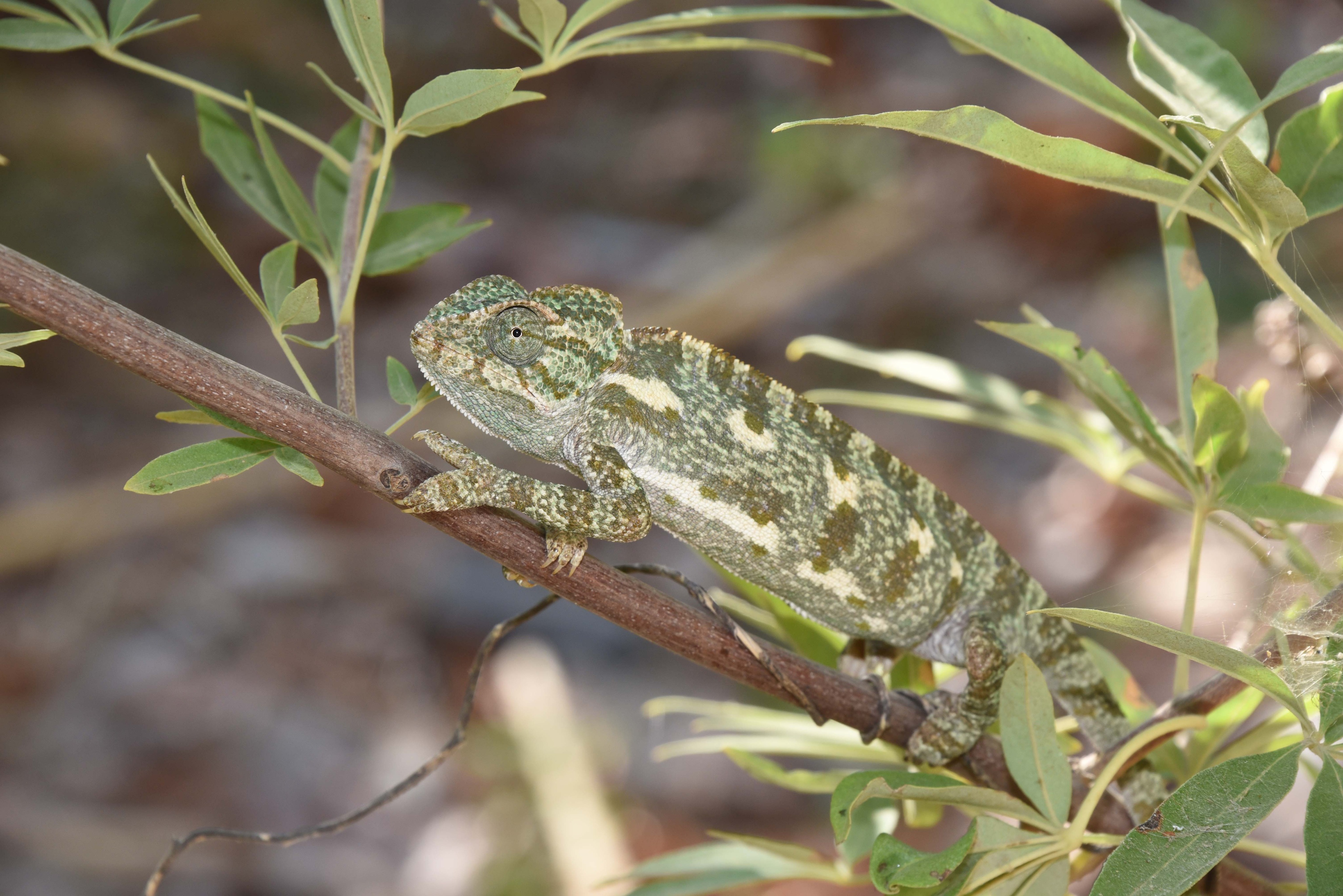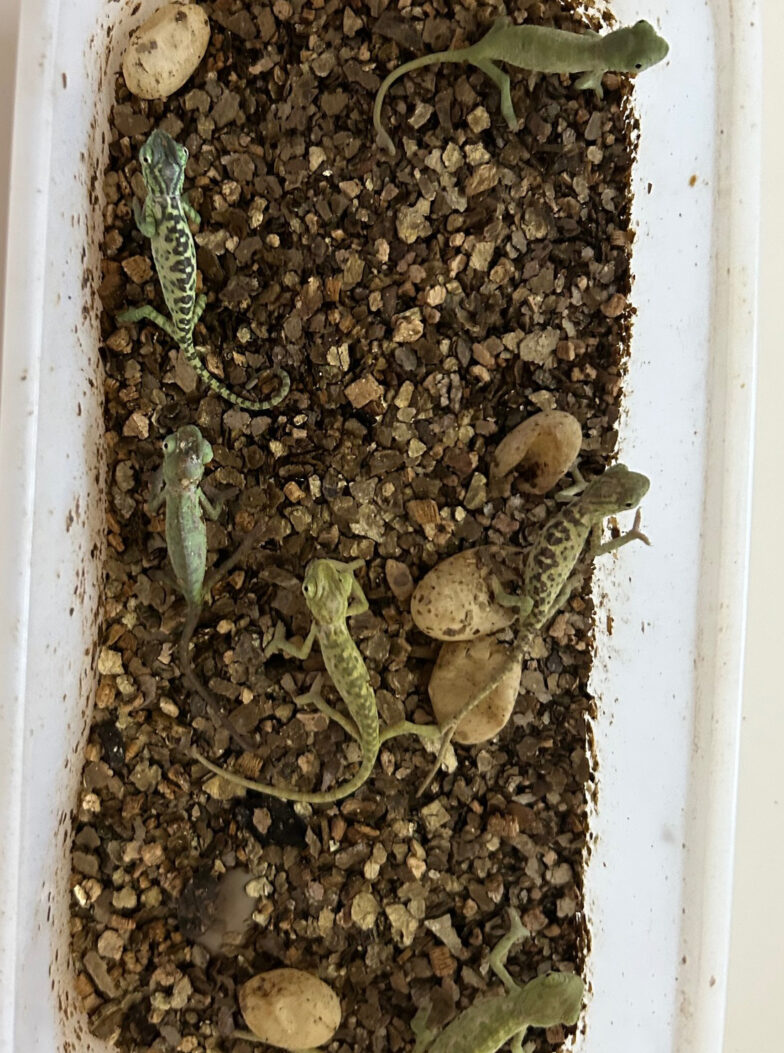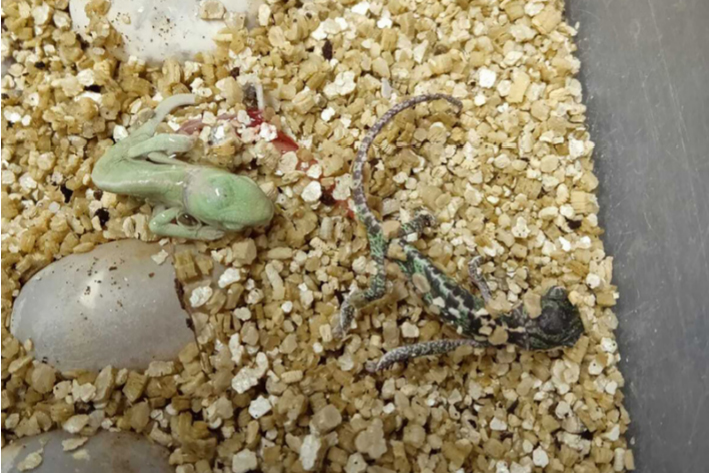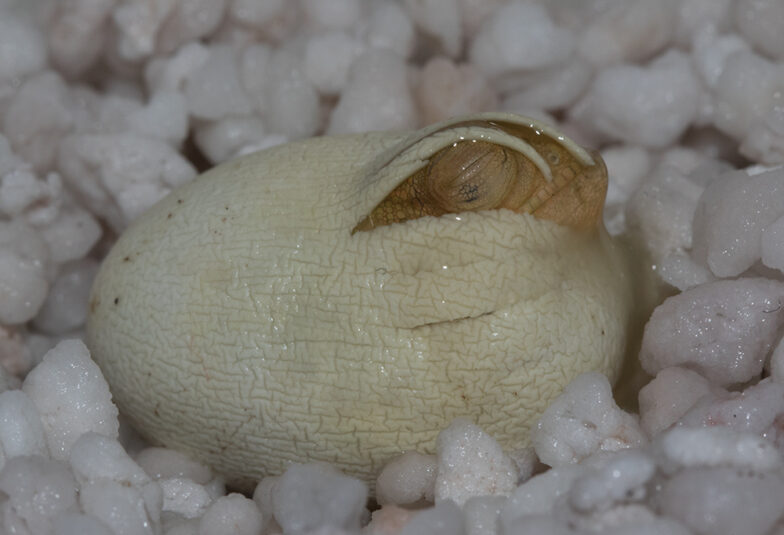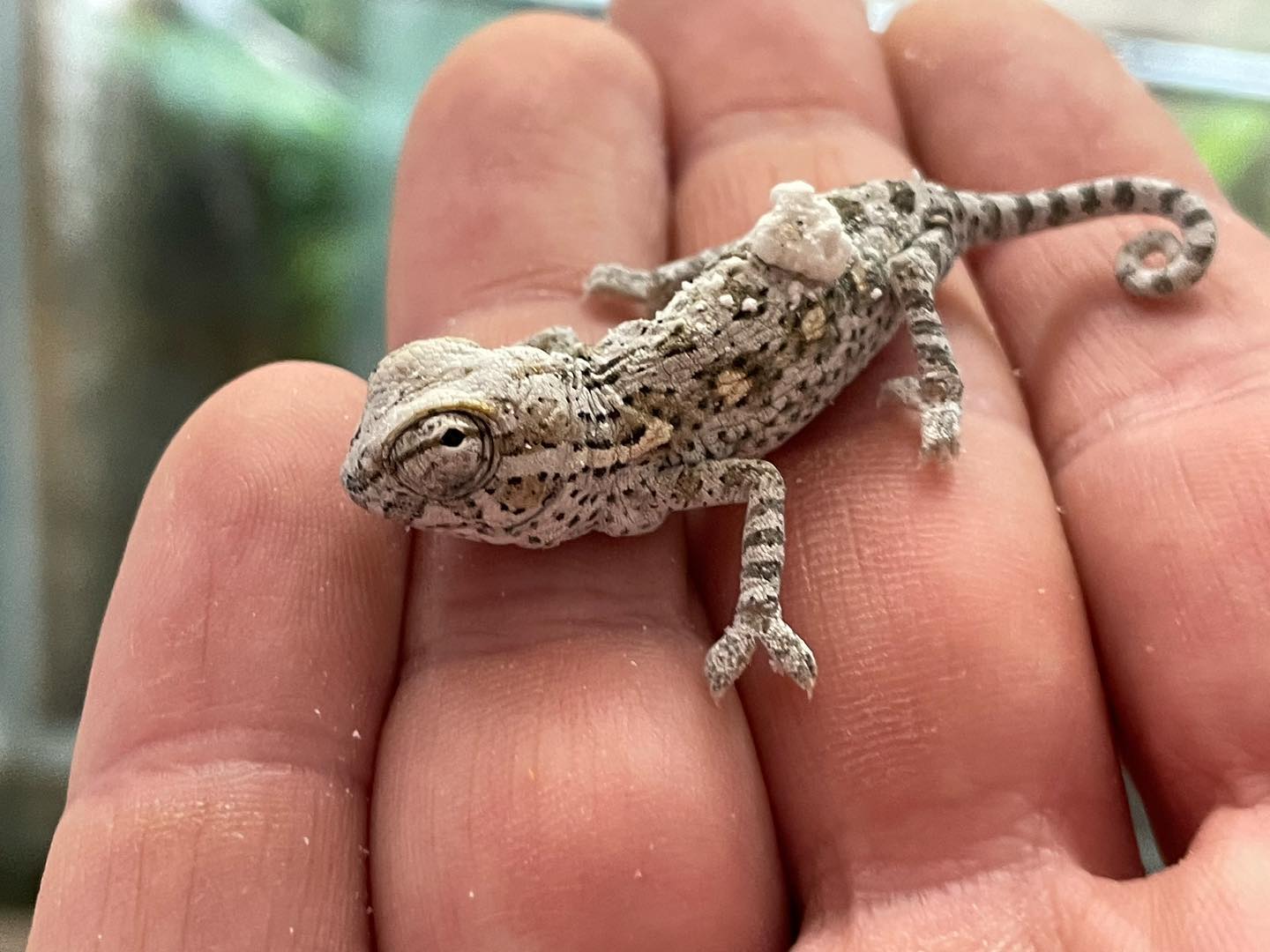The larger subspecies of the Veiled Chameleon, Chamaeleo calyptratus calcarifer, from the Tihama on the Arabian Peninsula has received little attention in the herpetoculture hobby in recent years. It is therefore not surprising that notes on this subspecies are not particularly frequent in the current literature and that there is also a lack of husbandry and breeding reports. Sophie Obermaier, a member of AG Chamäleons from Berlin, would like to change this and breed the species in the long term. She herself has several adults of the species and already has over 50 eggs that are currently being incubated. Anyone who has had experience with the subspecies, would like to participate by keeping a few animals themselves or would like to take on young animals for scientific work is cordially invited to contact Sophie by email at chartar.0702@gmail.com.
Presentation in Basel about the European Chameleon
Haltungsberichte Live lecturesMarkus Grimm, long-time member of the AG Chameleons and for many years entrusted in Switzerland with the implementation of expert courses for chameleon keeping, will give a detailed lecture on the European chameleon on 28 June 2024 in Basel (Switzerland).
The European chameleon (Chamaeleo chamaeleon) describes the archetype of the chameleon as such and thus has status character for the human conception of chameleons. The rather seldom kept chameleon species makes some demands on keeping and breeding, which Markus was able to fathom during trips to the habitat as well as during keeping in the terrarium. After a short introduction, which includes systematics, Markus gives insights into the habitat of this chameleon in nature. In addition, the audience will learn the most important parameters for successful keeping and breeding in the terrarium. So it will definitely be very exciting – anyone interested in chameleons should definitely watch this lecture!
Markus Grimm The European Chameleon – Habitat, husbandry & breeding
Schildkrotte Grubbe Regio Basel
Gasthof Zur Saline
Rheinstraße 23
4133 Pratteln-Schweizerhalle (Switzerland)
Lecture starts at 7.30 pm
Picture: Markus Grimm
Rhampholeon acuminatus offspring at Citizen Conservation
AG Interna NachzuchtenAG member Falk Eckhardt recently had a great success: His Rhampholeon acuminatus have successfully produced their first clutch of eggs. Congratulations!
The Nguru Spiny Pigmy Chameleon occurs in the wild exclusively in the small Mingu Nature Reserve in the eponymous Nguru Mountains in Tanzania. The IUCN classifies the species as critically endangered on the Red List of Threatened Species. Rhampholeon acuminatus is the first chameleon species for which a professional breeding programme has been set up as part of Citizen Conservation. The original animals come from Schönbrunn Zoo in Vienna (Austria). So far, there have only been F1 offspring (= offspring of wild-caught animals). Falk’s offspring, if they hopefully hatch, would be the first F2 offspring of the Nguru Spiny Pigmy Chameleon in the Citizen Conservation project. We keep our fingers crossed!
Picture: The eggs
Presentation in Cologne about chameleon keeping
Haltungsberichte Live lecturesJean-Dominique Dufraine, member of the AG Chameleons, will give a detailed lecture on 16 December 2023 in Cologne on the keeping of two chameleon species.
It will be about the tiger chameleon, Archaius tigris, and a species of stump-tailed chameleon, Rieppeleon brevicaudatus. The tiger chameleon comes from the Seychelles and has been successfully bred in terrariums for many years. In recent years it has found an increasingly small group of enthusiasts. The fact that the tiger chameleon can be kept well in a group is particularly important. Rieppeleon brevicaudatus, a species originally from Tansania, has been somewhat forgotten in recent years, having been bred in quite good numbers in the 2000s and up to the beginning of the 2010s. Wrongly so! Because these are very interesting chameleons that are quite easy to keep. Jean-Dominique has been keeping and breeding both species for several years and passes on tips and tricks on keeping and breeding. He hopes that both species will have a good chance of being reintroduced into German terrariums in the future and would like to actively contribute to spreading the joy of keeping these animals.
Jean-Dominique Dufraine Keeping and breeding Archaius tigris and Rieppeleon brevicaudatus
Verein für Aquarien- und Terrarienkunde Köln-Mühlheim e.V. 1910
DGHT City Group Cologne
Restaurant “Steakhaus bei Marco”
Clevischer Ring 120-122
51063 Cologne
Start of lecture 20.00 hrs
Photo: Archaius tigris by Jean-Dominique-Dufraine
Presentation in Basel about the European Chameleon
Haltungsberichte Live lecturesMarkus Grimm, long-time member of the AG Chameleons and for many years entrusted in Switzerland with the implementation of expert courses for chameleon keeping, will give a detailed lecture on the European chameleon on 01 November 2023 in Basel (Switzerland).
The European chameleon (Chamaeleo chamaeleon) describes the archetype of the chameleon as such and thus has status character for the human conception of chameleons. The rather seldom kept chameleon species makes some demands on keeping and breeding, which Markus was able to fathom during trips to the habitat as well as during keeping in the terrarium. After a short introduction, which includes systematics, Markus gives insights into the habitat of this chameleon in nature. In addition, the audience will learn the most important parameters for successful keeping and breeding in the terrarium. So it will definitely be very exciting – anyone interested in chameleons should definitely watch this lecture!
Markus Grimm The European Chameleon – Habitat, husbandry and breeding
The presentation will be held in German language!
DGHT City group Basel
Restaurant Schiff
4102 Binningen (Schweiz)
Presentation starts at 8 p.m.
Picture: Markus Grimm
Chamaeleo arabicus juveniles in the AG
NachzuchtenThe Arabian chameleon, Chamaeleo arabicus, is hardly ever bred in Europe at the moment. So it is all the more pleasing that this week a whole clutch of chameleons hatched successfully in Switzerland and Germany! Congratulations to Franziska von Ballmoos-Gasser, where the pictured hatchlings live. Franziska had given the parents to Rolf Attinger in winter 2021, where they successfully mated in 2022. After Rolf died unexpectedly, Franziska took back the animals and several eggs. Some of the eggs were given to a good friend of Rolf in Germany, the rest remained in Switzerland. Now 9 agile, good-looking youngsters have hatched in Switzerland and 14 in Germany. The aim is to join Rolf’s success with the species and to continue breeding the species with the same joy. At some point in the future, legal offspring of Chamaeleo arabicus should be offered in Europe. We sincerely hope that everything will continue to work out and that many more keepers will be able to enjoy the species!
Twins in Veiled Chameleons in Latvia
Short messages NachzuchtenThe hatching of two pairs of twins of Veiled Chameleons (Chamaeleo calyptratus) in Latvia has been reported from Riga. The parents live at Riga Zoo and the young hatched in March 2022. The twins were two male and two female Veiled Chameleons, each pair in one egg. They came from a clutch of 85 eggs, of which 48 eventually hatched. All four young animals were active at first and accepted food. At the age of two months, one of the juveniles died, the remaining three were still alive in February 2023.
The article also gives a brief overview of cases of twins in reptiles from the existing literature.
A review of twinning in lizards and a report of Veiled Chameleon (Chamaeleo calyptratus) twin births
Alessandro di Marzio, Elza Birbele, Lucia Puchades, Andris Lazdiņš
Herpetology Notes 16: 471-476, 2023
DOI:
Photo: One of the twin pairs at hatching
Keeping and breeding Parson’s Chameleons
Haltungsberichte Newspaper articlesThe keeping and breeding of Calumma parsonii parsonii has become quite successful in Germany in recent years. There are regular offspring and keeping is also becoming increasingly popular. In the current issue of Elaphe, the magazine of the DGHT e.V., there is a detailed report on keeping this beautiful, large chameleon species. It was written by three members of the AG Chamäleons.
They keep their animals in self-built terrariums made of aluminium profiles and Forex with a completely ventilated lid, and door as well as a full side area or in spacious winter gardens. Living plants provide sufficient cover. Both sexes are kept individually. Lighting is provided by Reptiles Expert metal halide lamps, Arcadia UV-B tubes, and HQIs. The lighting time is 10 to 12 hours in summer and winter. The enormous drinking needs of the species are satisfied by daily manual watering. In addition, feeding is rather sparse with only one adult food animal, e.g. a grasshopper, per chameleon per day (or the equivalent of several smaller food animals). A cooler winter hibernation, imitating the dry season in Madagascar, ensures a higher life expectancy and is therefore recommended by the authors.
Mating takes place in the German midsummer from July to August. The chameleons are put together for a few days until successful matings have taken place. The females are pregnant for four to six months. Between late December and early February, the female digs an elongated tube into the ground and lays 20 to 69 eggs. The incubation of the eggs takes place on perlite at 23 to 24°C. Weekly the eggs are sprinkled with distilled water. In February, a diapause is carried out at 13 to 14°C without further water supply. The young hatch after 15 to 24 months and are then raised individually. Unfortunately, the sex can only be determined at the age of 9 to 12 months.
All in all, this is a very detailed article with a lot of information for chameleon lovers who are interested in keeping this great species or are looking for one or two tips for breeding. In addition, the article discusses the distribution and habitat of the different colour varieties of Calumma parsonii parsonii on Madagascar.
Parsons-Chamäleons (Calumma parsonii parsonii) – Madagascar’s Gentle Giants
Alexandra Laube, Andreas Augustin und Thorsten Negro
Elaphe 3, 2023, pp. 12-25
Foto: Schlupf eines Parsons Chamäleons, fotografiert von Alex Laube
Presentation in Winterthur about the European Chameleon
Live lecturesMarkus Grimm, a long-time member of the AG Chamäleons and entrusted for many years in Switzerland with conducting expert courses for chameleon keeping, will give a detailed lecture on the European Chameleon on 14 April 2023 in Winterthur (Switzerland).
The European Chameleon (Chamaeleo chamaeleon) in a way describes the archetype of the chameleon as such and thus has status character for the human conception of chameleons. The rather seldom-kept chameleon species makes some demands on keeping and breeding, which Markus was able to fathom during trips to the habitat as well as in captivity. After a short introduction, which includes systematics, Markus gives insights into the habitat of this chameleon in nature. In addition, the audience will learn the most important parameters for successful keeping and breeding in the terrarium. So it will definitely be very exciting – anyone interested in chameleons should definitely watch this lecture!
Markus Grimm The European Chameleon – Habitat, Keeping and breeding in captivity
DGHT City Group Winterthur
Restaurant “Rössli”
8405 Winterthur (Switzerland)
The presentation starts at 8:00 p.m.
Chamaeleo namaquensis offspring in the AG
AG Interna NachzuchtenA great breeding success was achieved by AG-member and former AG-speaker Timo Weiß this week: His Chamaeleo namaquensis offspring hatched successfully. Congratulations!
The Namaqua chameleon is one of the few existing chameleons that actually occur in real deserts. It lives in the wild in Namibia, South Africa and Angola on the African continent. Unlike many other chameleon species, it inhabits mainly the ground and low shrubs.
Photo: One-day-old juvenile on the hand of the successful keeper




